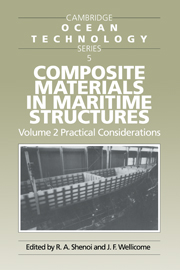Book contents
- Frontmatter
- Contents
- Preface
- List of Authors
- 1 Introduction
- 2 Design of Displacement Craft
- 3 Design of Dynamically Supported Craft
- 4 The Role of Adhesives
- 5 Practical Design of Joints and Attachments
- 6 Production of Ships with Single Skin Structures
- 7 Production of Yacht Hulls of Sandwich Configuration
- 8 Material Case Study - Failures and their Repairs
- 9 Response of Sandwich Structures to Slamming and Impact Loads
- 10 Fatigue Characteristics
- 11 Composites in Offshore Structures
- 12 Regulatory Aspects in Design
- 13 Quality and Safety Assessment
- 14 Design Management and Organisation
- Appendix
- Index
13 - Quality and Safety Assessment
Published online by Cambridge University Press: 04 August 2010
- Frontmatter
- Contents
- Preface
- List of Authors
- 1 Introduction
- 2 Design of Displacement Craft
- 3 Design of Dynamically Supported Craft
- 4 The Role of Adhesives
- 5 Practical Design of Joints and Attachments
- 6 Production of Ships with Single Skin Structures
- 7 Production of Yacht Hulls of Sandwich Configuration
- 8 Material Case Study - Failures and their Repairs
- 9 Response of Sandwich Structures to Slamming and Impact Loads
- 10 Fatigue Characteristics
- 11 Composites in Offshore Structures
- 12 Regulatory Aspects in Design
- 13 Quality and Safety Assessment
- 14 Design Management and Organisation
- Appendix
- Index
Summary
INTRODUCTION
The manufacture of the hulls of ships and boats or components such as piping for use in offshore units requires adherence to high levels of quality with regard to certification of processes and qualification of operators. This is very important especially in view of the fact that specification of quality through non-destructive testing and inspection of the final product is difficult to achieve.
This Chapter aims at outlining briefly the role of the Quality Assurance tool and the manner in which it can be used to control more efficiently the whole process of design, manufacture and operation of marine structures made from FRP materials, based on applicable rules and regulations. The ‘input’ to be taken into consideration from the preliminary stages onwards will be mentioned. At each of the design, manufacture, installation and in-service stages, particular attention will be devoted to statutory and rule requirements.
GENERAL ASPECTS OF QUALITY ASSURANCE
Some Definitions
Quality: the totality of characteristics of an entity that bears on its ability to satisfy stated and implied needs (ISO/DIS 8402–1991, art.2.1)
Quality assurance: all the planned and systematic activities implemented within the quality system, and demonstrated as needed, to provide adequate confidence that an entity will fulfil the requirements for quality (ISO/DIS 8402–1991, art.3.5)
Quality system: the organisational structure, responsibilities, procedures, processes and resources needed to implement quality management (ISO/DIS 8402–1991, art.3.6)
The ISO Standards
Depending on the extent of its scope of application, ISO defines three possible standards to which the quality system has to comply:
ISO 9001: 1987 – Quality systems – Model for quality assurance in design/development, production, installation and servicing
[…]
- Type
- Chapter
- Information
- Composite Materials in Maritime Structures , pp. 260 - 280Publisher: Cambridge University PressPrint publication year: 1993

